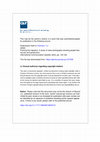Visual Communication by Keith Greenwood

Handbook of Visual Communication: Theory, Methods, and Media, 2020
Profile pictures are ubiquitous and salient parts of most online accounts and provide a window no... more Profile pictures are ubiquitous and salient parts of most online accounts and provide a window not only into individual users but also into the larger online community's culture. Profile pictures have been called "one of the most telling pieces of self-disclosure or image construction" in online communities, and users face dizzying freedom when deciding on their selection. Such choices have been studied in discrete contexts, such as how personality type affects profile picture selection on Twitter, but they have not yet been studied across platforms to see how users stylize their representations to often distinct and segmented audiences. Informed by literature in internet studies, digital media, and visual sociology, this qualitative study offers a seminal look into how profile pictures differ across platforms and how user attributes and perceived audiences affect such decisions. It does so through personality assessments, visual analyses, and in-depth interviews. The findings reveal that the participants sampled in this study overwhelmingly prefer polychromatic images, and a majority prefer to have a unique picture on each platform. These same users are comfortable having their identifiable features in their profile pictures, and those who are more extroverted prefer to share the frame with someone else.

The International Communication Gazette, 2019
Human migration due to political upheaval is rapidly accelerating, yet scholarly attention to ref... more Human migration due to political upheaval is rapidly accelerating, yet scholarly attention to refugees' visual news representations has lagged. Using a visual analysis informed by the transnational writings of Yuval-Davis related to the politics of belonging and the peace/conflict frame literature, 811 images primarily depicting migration from Turkey into Europe in 2015 and submitted to the Pictures of the Year International competition were examined. Analysis determined that, despite billions of dollars in aid and millions of migrants who have benefited from food assistance and other development opportunities , the photographers overwhelmingly highlighted the migrants' transitory nature, vulnerability and differences while minimizing any attempt to depict the shared connections or integrations that were occurring. As media are orienting devices, this has profound implications for how migrants are regarded on both the individual as well as the collective levels.
Papers by Keith Greenwood
Visual Communication Quarterly, 2017
Visual Communication Quarterly, 2017
Visual Communication Quarterly, 2011
... View all references; Davenport, Randle, & Bossen, 200711. Davenport, L., Randle, Q. and B... more ... View all references; Davenport, Randle, & Bossen, 200711. Davenport, L., Randle, Q. and Bossen, H. 2007. Now you see it, now you don't: The problem with newspaper photo archives. ... Attachment , New York, NY: Basic Books. View all references; Sanford, 195539. ...
Journal of Marketing Communications, 2013
ABSTRACT
Journal of Marketing Communications, 2013
ABSTRACT
Journalism Practice, 2009
... With the exception of a comparison of themes in Rockwell paintings to those found in feature ... more ... With the exception of a comparison of themes in Rockwell paintings to those found in feature photographs (Mendelson, 200416. Mendelson, Andrew. 2004. Slice of Life Moments as Visual 'Truth'. ... Mendelson, Andrew. 2004. Slice of Life Moments as Visual 'Truth'. ...

International Communication Gazette
Human migration due to political upheaval is rapidly accelerating, yet scholarly attention to ref... more Human migration due to political upheaval is rapidly accelerating, yet scholarly attention to refugees' visual news representations has lagged. Using a visual analysis informed by the transnational writings of Yuval-Davis related to the politics of belonging and the peace/conflict frame literature, 811 images primarily depicting migration from Turkey into Europe in 2015 and submitted to the Pictures of the Year International competition were examined. Analysis determined that, despite billions of dollars in aid and millions of migrants who have benefited from food assistance and other development opportunities, the photographers overwhelmingly highlighted the migrants' transitory nature, vulnerability and differences while minimizing any attempt to depict the shared connections or integrations that were occurring. As media are orienting devices, this has profound implications for how migrants are regarded on both the individual as well as the collective levels.

Every day mass media outlets provide audience members with information about current events invol... more Every day mass media outlets provide audience members with information about current events involving government and elected officials. The words, photographs and graphics used by media present the information editors think is important to informed citizens. But aside from simply presenting information about an issue, person or event, reporters and editors also make decisions about what information will be presented and how it will be organized for the audience. The selection of topic, story direction, sources, story organization and even word usage combine to suggest a point of view for the audience to adopt (Entman, 1993). Stories reporting hostile actions toward the United States may be presented from that point of view that the threatening government or organization is wrong and should be dealt with forcibly. Similarly, stories reporting unethical or illegal activity may present a point of view that the subject should face legal consequences. The point of view suggested in a news account is called a frame (Entman, 1993). Framing is not limited to textual accounts of issues and events. Photographers make decisions about what to include in an image and how it will be shown that suggest frames for interpreting the images. The combination of elements captured in the image, their relationship to the camera and lighting suggest whether the viewer should adopt a sympathetic, respectful, disdainful or some other attitude toward the subject. Presidents of the United States are not immune from visual framing. The combination of camera angle, distance from the camera and what the photographer chooses to capture within the Picturing Presidents 2 boundaries of the image suggests a frame to the viewer for interpreting not only the activity of the President but also how to feel about that activity. Research has explored the framing of Presidents in published photographs, but the publication process involves framing decisions of the editors to fit with the point of view of the publication. Research has not addressed framing that might be observed in photographs outside of the publication process. The purpose of this study is to examine how United States Presidents are visually framed in photographs that have been recognized by experts as examples of photographers' best work. Review of Literature Prior research has attempted to define framing and its presence in media. Research regarding the portrayal of people in photographs has explored the use of camera angle and subject-to-camera distance, whereas the portrayal of Presidents has largely focused on images published in news magazines. Framing Framing refers to cognitive devices media and audiences use to organize and make

Photojournalism and Citizen Journalism
The proliferation of cameras on cellphones and access to high-quality digital cameras has increas... more The proliferation of cameras on cellphones and access to high-quality digital cameras has increased the ability of average citizens to capture and share photographs and video. The inclusion of user-generated visual content by news organizations, especially at a time of newsroom contraction, has been a source of consternation for professional photojournalists, who have emphasized their professional training and skill. Though scholars have explored the perceptions photojournalists and citizen photographers have of photojournalism and of each other, little attention so far has been directed to the visual content of citizen photojournalism, the extent to which it adheres to established photojournalism conventions, and its incorporation by mainstream news organizations. This research addresses this absence. Drawing on a content analysis of user-generated images, this study finds that in a situation involving coverage of an ongoing story of significant impact in a community, there was little citizen photojournalism presented within the mainstream coverage. Further analysis reveals that while there is some overlap between events captured by professional and citizen photojournalists, the photographs made by citizens do not generally reflect the aesthetic standards expected of professionals. The results begin to provide practical examination of conceptual concerns expressed by photojournalists regarding the use of citizen-generated content.

Profile pictures are ubiquitous and salient parts of most online accounts and provide a window no... more Profile pictures are ubiquitous and salient parts of most online accounts and provide a window not only into individual users but also into the larger online community’s culture. Profile pictures have been called “one of the most telling pieces of self-disclosure or image construction” in online communities, and users face dizzying freedom when deciding on their selection. Such choices have been studied in discrete contexts, such as how personality type affects profile picture selection on Twitter, but they have not yet been studied across platforms to see how users stylize their representations to often distinct and segmented audiences. Informed by literature in internet studies, digital media, and visual sociology, this qualitative study offers a seminal look into how profile pictures differ across platforms and how user attributes and perceived audiences affect such decisions. It does so through personality assessments, visual analyses, and in-depth interviews. The findings revea...











Uploads
Visual Communication by Keith Greenwood
Papers by Keith Greenwood